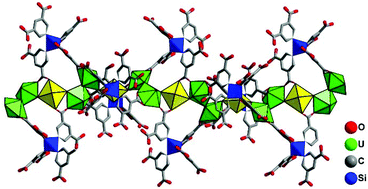Occurrence of polyoxouranium motifs in uranyl organic networks constructed by using silicon-centered carboxylate linkers: structures, spectroscopy and computation†
Abstract
Four novel polyoxouranium-based uranyl carboxylates have been constructed by using a combination of three silicon-centered carboxylate ligands and polyoxouranium building blocks. Interesting oligomerization of the uranyl groups from three types of tetrameric units in 1 and 2 to octameric [(UO2)8(μ3-OH)6(μ2-OH)2(H2O)4]8+ in 3 and ultimately infinite polyoxouranium chains in 4 was observed. The 3D structure of 2 contains two different linear tetramers, whose structures are totally different from seven types of tetranuclear motifs previously observed in uranyl carboxylates. Compound 3 displays a rare octanuclear polyoxouranium brick; it is fabricated by the association of eight uranyl units in pentagonal-bipyramidal geometry that involves the edge-sharing polyhedral connection mode, which are further linked by four isolated UO7 pentagonal bipyramids to create a complicated 3D framework. These newly synthesized hybrid materials were extensively characterized by single crystal analysis, thermogravimetric analysis (TG) and different spectroscopic techniques (IR, UV-vis, and luminescence spectroscopy), which show well-resolved characteristic “five-finger” emission of the uranyl ions under excitation at 420 nm. Relativistic density functional theory (DFT) was used to explore five model compounds that theoretically simulate experimental real compounds. Experimental spectroscopy was rationalized by electronic-structure analysis.



 Please wait while we load your content...
Please wait while we load your content...